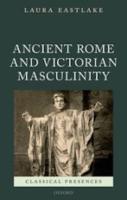
OUP (2018) h/b 227pp £65 (ISBN 9780198833031)
E. begins this book with two marvellous images. The first is Canova’s huge nude statue ‘Napoleon as Mars the Peacemaker’. The Greco-Roman world is exploited to provide the soon-to-be Emperor with military splendour, Augustan authority and Hellenic aesthetics. The last aspect bothered even Napoleon: trop athlétique, he said, and banned it from public viewing. (Canova learned his lesson: when he came to do George Washington, he dressed him up in cuirass, tunic and mantle.) The statue ended up in Apsley House, dominating, or rather overcrowding, the Wyatt stairwell. The effect is comic; Wellington’s guests apparently used the statue as umbrella stand. Is it only Napoleon who is mocked, or the aspects of classical antiquity he represents?
The second of E.’s images is a portrait of Oscar Wilde by the New York photographer Napoleon Saronyi. He wears his hair (unusually, so far as I can judge from other portraits) combed forward in a ‘bang’. The style seems Roman. Whether it represents Nero, as E. claims, I am less sure. (There is a portrait of Trajan with just such a hairstyle at Ostia.) But Wilde does seem to be claiming a part for Rome in the ancestry of 19th-century aestheticism.
The images frame the 19th century, over which E. traces the many ways in which Rome was received: ‘a model of stoic virtue, of dangerous revolutionary sentiment … of persecution … of aesthetic accomplishment … of imperial splendour, and at the same time as a warning of imperial decline and fall … with a specific focus on how those receptions were deployed to create usable models of masculinity.’
Part 1 of the book deals with the channels of classical reception, the educational curriculum and the institutions where that curriculum was imparted. Part 2 considers the problematic nature of Roman ideas and people in relation to domestic politics: was Julius Caesar to be seen as reformist or revolutionary? In all the parliamentary debates on Reform, there is apparently only one mention of Julius Caesar. The difficulty continues later on, with Napoleon III over the Channel attempting to re-enact his uncle’s imperial project and writing a self-advancing Life of Julius Caesar. But the focus shifts to parliamentary activity, Trollope’s Life of Cicero and the Palliser novels. Part 3 considers Rome as model for the empire, both in its days of military glory (railways like Roman roads, cantonments like castra) and in decline (the hardy barbarian gets together with the softly civilised Roman to produce the all-purpose modern Briton). Part 4 covers the last decades of the century, with Rome often seen as the pattern of debauchery and cruelty, to be either imitated or shunned. There is a splendid treatment of the toga-play (bloodcurdling shot of Franklin McLeay as Nero on the dust jacket). The last section looks at the role of classical stereotypes in the run-up to the Great War and its conduct, along with the case made by some educationalists for the irrelevance of classics in general.
As one might expect, words like ‘male’, ‘masculine’, ‘masculinity’ (even ‘masculinities’), ‘manly’ come up very often indeed. But (possibly speaking as an unregenerate male) I did have a little difficulty with this. Yes, almost all the sources consist of men writing about and for men, explaining, encouraging or discouraging things which are (were), as it happens, mostly done by men. But to discuss the Masculine you really do need a Feminine Other. Sometimes we do have one: Glencora Palliser makes an appearance, Wilkie Collins’ Antonina has a contrast between male and female virtues at its heart (whether or not one goes along with Collins in this), and Cleopatra has a good innings in Chapter 6. But much of the time we don’t. Maybe Stalky’s crude hobbledehoy violence does seem boys’ stuff rather than girls’. But I think it needs arguing, and in very many passages we could have been reading about values in general, not simply masculine ones.
A classicist reading E.’s book will trip up over observations like ‘Fasces were carried by lictors accompanying … consuls and tribunes’, or where Macaulay is described as ‘sticking closely to his Virgilian model, wherein the focus switches from Aeneas and the Trojans to Turnus and the Latins after the sixth book’. A pedant may be bothered by ‘is’ for ‘are’ on p. 67, a missing ‘of’ on p. 129, or decimal currency introduced in 1972 not 1971 (p. 93). But it is hard not to enjoy E.’s wide reading, her careful choice of sources, her detailed interpretations, her well-chosen illustrations. From the early decades of the nineteenth century, when the Roman ideal seemed to have been monopolised by Napoleon, while Greek imagination and flexibility could be better appropriated in Britain, to the militarising ideologies of turn-of-the-century imperialists, we are taken through a vast range of different and often contradictory interpretations, literary, political and cultural. Distinctly enlightening.
Keith Maclennan
